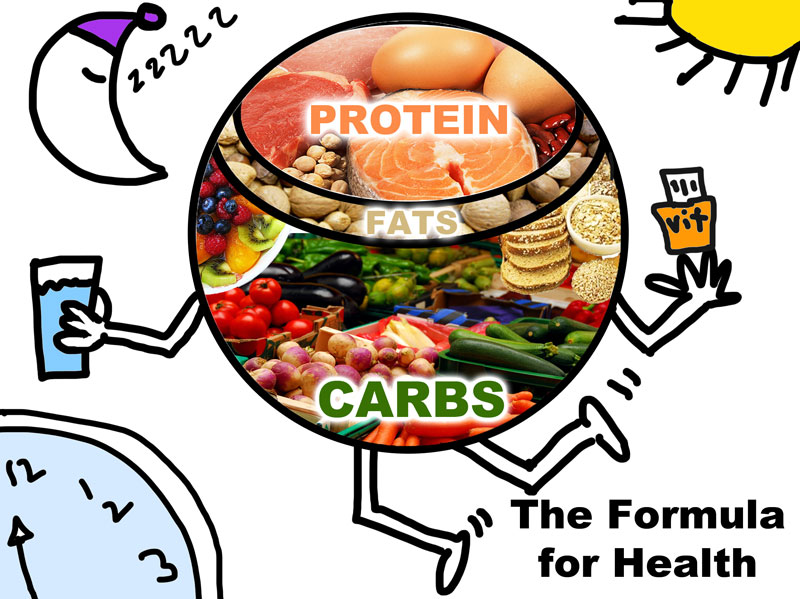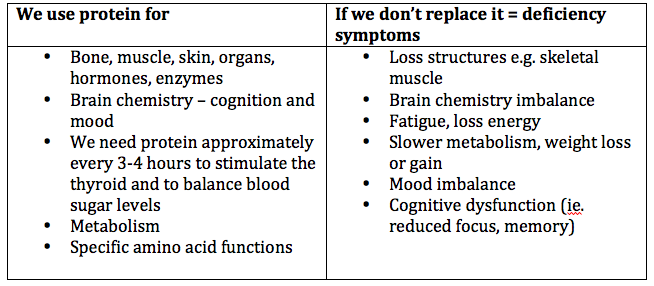We are made of protein, so we need it in certain quantities to maintain our structures, such as muscle, skin and bone. Protein is made up of chains of tiny units called amino acids. These not only make up the architecture of our body; each amino acid also has a unique function of its own. So we also need protein for immunity, hormones, brain chemistry, enzymes, and crucial blood components (such as albumin which keeps blood pumping around the body).
Now here’s the crunchy bit: our bodies use and/or lose approximately one gram (1g) of protein per kilogram (Kg) of body weight in urine every day as part of tissue turnover. That’s a very broad estimate, but it’s a mid-ground for healthy, active adult. It shoots a dart between the Australian Government recommendations (Recommended Daily Allowance, or RDA) and the Acceptable Macronutrient Distribution Ranges, (or AMDR) according to the American Journal of Clinical Nutrition (2002a).
An RDA may be considered the minimal amount needed to prevent deficiency, whereas optimal levels correlate with additional health benefits such as lean body mass, bone density and cardiovascular protection.
So if we’re peeing it out, we have to put it back in. And if we shoot for optimal, on average this equates to approximately a palm volume of animal protein OR a hand volume of vegetable protein per meal. That’s right – three times daily.
If we don’t replace the protein, our body will dissolve and sacrifice some protein from our body, such as skeletal muscle, in order to keep vital functions going. This is a wonderful preservation system but can be a dampener to long-term health, not to mention the ‘Blue Steel’ department (reduced metabolism, muscle loss, collagen loss).
Can we eat all of our protein at once, such as a small donkey at dinner-time? Well, it isn’t optimal. Our amino acids deplete within a matter of hours; so if we want to have ongoing optimal function, it’s better to eat a small protein portion every 3-4 hours. Many of us also find benefit in having some protein-based snack in between meals to balance blood sugar levels.
For example: eggs for breakfast; lentil dahl for lunch; salmon and veg for dinner, plus a handful of nuts to snack on through the day.
Further to this: amino acids are the main ingredients of the brain’s chemical cocktails. Specific amino acids are converted (as the main ingredient) into specific neurotransmitters. For example, tryptophan converts to serotonin (required for us to feel happy); and tyrosine converts to dopamine (required for short term memory, coping, and motivation). So if you’d like a party in your brain, invite optimal dietary protein.
So….
How do we know if we are getting enough protein?
A physical indicator of protein sufficiency is the finger pulp test:
Squeeze your fingertip firmly for a few seconds; then release. The pressed tissue should bounce back immediately. If it takes a few seconds to spring back, you likely need to boost your dietary intake of protein. Your health practitioner may also test your blood levels of Urea and Creatinine, and assess these markers of protein metabolism as part of your health picture.
Specific amino acid deficiency (the cherry on the cocktail).
Sometimes people use and lose (or simply require more) of particular amino acids. In this case, they experience deficiency symptoms, such as those listed above. The general daily protein quota may not supply enough of certain amino acids to replace what has been lost of what is required. This often occurs with stress. In this case, it is best to not only have enough dietary protein, but to consult a nutritionist who can identify and treat the deficiencies as well. Nutritionists can test plasma (or urine) amino acids and supplement individual amino acids.
Need more protein? Here’s how to get it…

 Hankering for some protein? Check out the recipes and cooking videos on this site!
Hankering for some protein? Check out the recipes and cooking videos on this site!
Cheesy Spinach Muffins coming soon…
References:
Australian Government (Department of Health and Ageing and National Health and Medical Research Council) and Ministry of Health (2006). Nutrient Reference Ranges for Australia and New Zealand, Including Dietary Intakes. This can be found at: http://www.nhmrc.gov.au/guidelines/publications/n35-n36-n37.
Florida Dietetics Association (2010). Optimal Protein Intake and The RDA. A Presentation delivered at Orlando, Florida. A summary of the presentation is available at: http://www.slideshare.net/healthspaninstitute/optimal-protien-intake-the-recommended-daily-allowance-rda.
Heany, R.P (2002). Protein and Calcium: antagonists or synergists? American Journal of Clinical Nutrition, 75 (4), 609-610.
Houston, D.K, et al (2008). Dietary protein intake is associated with lean mass change in older, community-dwelling adults: the Health, Aging, and Body Composition (Health ABC) Study. American Journal of Clinical Nutrition, 87 (1), 150-155.
Hu, et al (1999). Relative Risks (RR) of Ischemic Heart Disease in 80,082 Women. American Journal of Clinical Nutrition, 70, 21-227.
Vellas, B.J, et al (1997). Changes in Nutritional Status and Patterns of Morbidity Among Free Living Persons: A Ten Year Longitudinal Study. Nutrition, 13, 505-519.



Linda,
Thanks for your entertaining and informative posts! 🙂
Just wondering – in your table you say that protein every 3-4 hr stimulates the thyroid – how exactly does it do that?
Curious Tess x
p.s. I am now going to make larb in a blender for dinner… YUM!